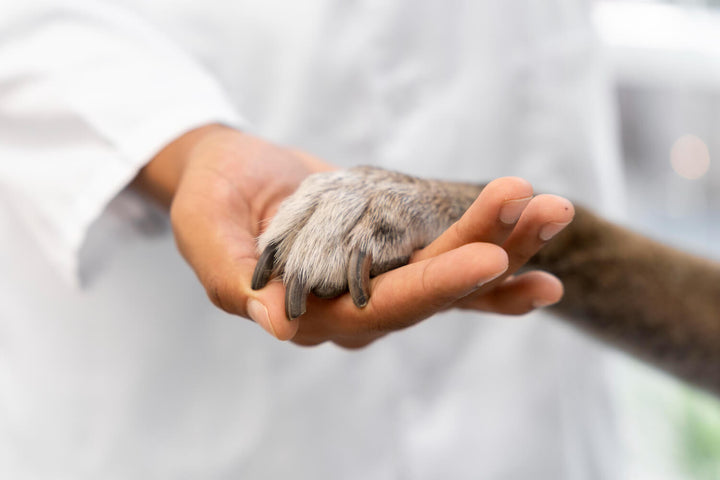Meet the Dobermann - a breed that exudes power, intelligence, and unwavering loyalty. Known for their sleek black and tan coats and a presence that demands respect, Dobermanns are not just another pretty face in the dog world. They have a rich history, captivating traits, and a unique position in the hierarchy of canine breeds. In this article, we'll dive deep into the world of Dobermanns, unraveling their story, and discovering what makes them exceptional companions.
Did You Know these Facts about the Dobermann?
-
The Dobermann is named after its creator, a German tax collector named Louis Dobermann. In the late 19th century, Dobermann decided to breed a dog that combined strength, agility, and loyalty for his protection during his tax collection duties.
-
While Dobermanns are often prized as formidable protectors, they are known for their gentle and loyal nature towards their human families. They're affectionate and thrive on human companionship.
-
Dobermanns have served in both World Wars as guard dogs, messengers, and even in search and rescue missions. Their exceptional courage and intelligence makes them invaluable assets during emergencies.
-
These dogs are known for their well-muscled bodies, which give them a regal yet athletic appearance. Their sleek coats, often black and tan, highlight their striking physique.
- Dobermanns are highly trainable and intelligent dogs. They excel in obedience training and often participate in dog sports, showcasing their agility and mental acumen.
While Dobermanns are certainly admired, they don't hold the top spot in terms of popularity among dog breeds. They rank moderately in popularity when compared to other formally registered breeds. This might be because they require an experienced owner who understands their need for training, socialization, and exercise. Nonetheless, the Dobermann Pinscher ranked #15 in the AKC´s popularity list of 2022.

Traits of the Dobermann Breed
Overall Personality. Dobermanns are known for their intelligence, loyalty, and alertness. They are often described as "gentle giants" due to their loving and protective nature towards their families. They are exceptionally obedient and eager to please, making them excellent companions for those who invest in proper training and socialization.
Family Life. Dobermanns can be wonderful family dogs when raised and trained properly. They are affectionate with children and often form strong bonds with their human family members. However, due to their protective nature, they require early socialization to ensure they are well-adjusted around other pets and unfamiliar people.
Physical Appearance. Dobermanns are a medium to large breed with a well-muscled and athletic body. They typically have a short, sleek coat that comes in various colors, with the classic black and tan being the most recognizable. Their wedge-shaped head and alert, expressive eyes give them a distinctive appearance.
Sociability. These dogs thrive on human interaction and can be prone to separation anxiety if left alone for extended periods. They are known to be protective, making them excellent guard dogs, but this trait requires early training to ensure they are well-behaved around guests.
Average Sizes & Life Expectancy
- Height: 25 to 28 inches tall (63 to 72 cm)
- Weight: 71 to 99 pounds (32 to 45 kg)
- Life Expectancy: Around 10 to 13 years
Detailed Description of the Dobermann Breed
Physical Appearance. Dobermanns are known for their sleek and athletic build. They have a well-proportioned body that exudes both power and grace. Their wedge-shaped head is distinctive, with a strong, elongated muzzle and a well-defined stop.
Their ears are often cropped to stand erect, giving them an alert and imposing look. However, it's important to note that ear cropping is a controversial practice and is banned or restricted in many countries.
One of the most recognizable features of the Dobermann is their short, smooth coat. While black and tan are the most common color combination, they can also come in blue and tan, red and tan, and fawn and tan. Their coat is low-maintenance, requiring only occasional brushing to keep it in good condition.
Temperament and Personality. Dobermanns are often described as "gentle giants." While their physical appearance may be imposing, their personalities are affectionate, loving, and loyal. They are known to form deep bonds with their families and are often referred to as "velcro dogs" because they love to be close to their human companions.
They are highly intelligent, which can sometimes lead to stubbornness if not properly trained and mentally stimulated. Early socialization and obedience training are crucial for Dobermanns to ensure they are well-adjusted and obedient adults. Positive reinforcement methods work exceptionally well with this breed.
Dobermanns are not typically aggressive, but they have a strong protective instinct. They may be reserved around strangers, which makes them excellent guard dogs. However, early socialization is essential to ensure they are well-behaved and can differentiate between welcome guests and potential threats.
Adaptability. Dobermanns are adaptable dogs and are best suited for families with an active lifestyle. They require regular exercise to keep them mentally and physically stimulated. Long walks, runs, and playtime in a secure yard are essential for their well-being.
Apartment living is possible for Dobermanns, but it requires a dedicated owner who can provide them with the necessary exercise and mental stimulation.
They are sensitive to extreme temperatures, so they should not be left outside in harsh weather conditions.
Dobermanns are excellent family dogs when raised with care and training. They are known to be good with children and can be very affectionate toward them. However, due to their size anbd protective nature, supervision is essential, especially when they are around small children.
Care Guidelines. Dobermanns are active dogs and require regular exercise. Aim for at least an hour of physical activity each day, which can include walks, runs, and an energetic playtime.
Their intelligence demands mental stimulation. Puzzle toys and obedience training are excellent ways to keep their minds engaged.
Dobermanns have a short coat that is low-maintenance. Brushing them once a week and the occasional bath are usually sufficient.
Regular veterinary check-ups and vaccinations are essential to keep them healthy. Be aware of breed-specific health concerns, including heart issues and hip dysplasia.
Training Strategies. Dobermanns are among the most intelligent dog breeds. They have an innate ability to learn and excel in various canine activities, from obedience and agility to protection work. Their sharp minds require mental stimulation, making them excellent candidates for advanced training.
Dobermanns are vigilant and highly alert dogs. They make excellent guard dogs due to their natural suspicion of strangers. Their protective instincts, when properly channeled through training, can provide a sense of security for their owners.
However, early socialization with people and other dogs is crucial to ensure they are well-adjusted and comfortable in unfamiliar situations.
Notable in History and Pop Culture. The history of the Dobermann is closely tied to its founder, Louis Dobermann, a tax collector in Germany in the late 19th century. He aimed to create a breed that was protective and loyal, and his efforts led to the development of the Dobermann we know today.
In pop culture, Dobermanns have made appearances in various films and television shows. Perhaps one of the most famous Dobermanns in pop culture is "Scooby-Doo," a beloved character in the animated series.
What to expect when living with the Dobermann Breed
Personality. Dobermanns are renowned for their intelligence and loyalty. As a member of your family, expect a Dobermann to be affectionate and protective. They form deep bonds with their owners and can be quite loving and gentle. However, they are also known for their alertness and protective instincts. They may be reserved around strangers, making them excellent guard dogs. Early socialization is key to ensure they are well-mannered and confident around new people and situations.
Ideal Environment. Dobermanns thrive in environments where they can receive ample exercise and mental stimulation. They are active dogs and require daily physical activity to remain healthy and happy. A home with a securely fenced yard is ideal for play and exercise, but they cannot be left alone for long periods. They are happiest when close to their human family and can develop separation anxiety if left alone for long periods.
While they can adapt to apartment living, it requires a commitment to regular exercise routines. Additionally, they are sensitive to extreme weather conditions, so they should not be left outside in harsh climates.
Maintenance Level. Dobermanns have short coats that are relatively low-maintenance. They shed moderately, so regular brushing helps keep their coat in good condition and minimizes shedding. Bathing is necessary only when they become dirty. Their ears should be checked regularly for signs of infection, and their teeth should be brushed to maintain oral health. They are sensitive to cold weather, so provide them with appropriate protection when it's chilly.
Overall Health Expectations and Best Health Tests for the Dobermann Breed
Health Considerations. Dobermanns have an average lifespan of 10 to 13 years. While they are a relatively healthy breed, they can be predisposed to certain conditions. Some of the common health issues in Dobermanns include:
- Dilated Cardiomyopathy (DCM) - This is a heart condition that affects the heart's ability to pump blood effectively. Regular heart screenings and monitoring are essential for Dobermanns.
- Hip Dysplasia - Dobermanns can be prone to hip dysplasia, a genetic condition that affects the hip joints. Regular X-rays and evaluations can help detect and manage this issue.
- Von Willebrand's Disease - This is a bleeding disorder that affects Dobermanns. Testing for von Willebrand's disease is crucial for breeding dogs to prevent passing on the condition.
- Hypothyroidism - Dobermanns can develop thyroid issues, which can affect their metabolism. Regular thyroid function tests are important for early detection and management.
Recommended Health Tests. Responsible breeders conduct health tests on their breeding dogs to minimize the risk of passing on genetic conditions. Dobermanns should take Cardiac Evaluations, Hip Evaluations, Thyroid Function Tests, and Von Willebrand's Disease Tests.
Best Nutrition, Diet & Supplements for the Dobermann Breed
Nutrition and Diet. Dobermanns require a high-quality source of animal protein in their diet. Look for dog foods with real meat as the primary ingredient.
Protein is crucial for muscle maintenance and overall vitality.
Healthy fats are essential for Dobermanns' energy levels. Opt for dog foods with moderate fat content, usually around 12-20%. Omega-3 fatty acids, found in fish oil, are beneficial for their skin and coat health.
While Dobermanns need carbohydrates for energy, avoid excessive grain-based diets. Opt for foods with whole grains like brown rice or sweet potatoes. Some Dobermanns may do well on grain-free diets, but consult your vet for guidance.
Incorporate fruits and vegetables like carrots, spinach, and blueberries into their diet. These provide essential vitamins, minerals, and antioxidants.
Hydration is Key. Adequate hydration is essential for Dobermanns. Encourage your dog to drink plenty of fresh water.
Supplements. While Dobermanns can receive essential nutrients from a balanced diet, some supplements can support their overall health. Omega-3 fatty acids, such as fish oil, can help maintain healthy skin and coat.
Additionally, consider supplements like glucosamine and chondroitin to support joint health, as Dobermanns can be prone to hip dysplasia.
Foods to Avoid. Certain foods can be harmful to Dobermanns. High-purine foods like raw meats should be avoided. Additionally, foods that are toxic to dogs should be avoided; grapes, onion, chocolate, and raisins are in this category.
Grooming Requirements for the Dalmatian Breed
Coat Maintenance and Shedding. Dobermanns have a short, dense coat that is smooth to the touch. They are moderate shedders, which means you can expect some loose hair throughout the year, with slightly heavier shedding in the spring and fall. Regular brushing with a rubber grooming mitt or a soft bristle brush will help remove loose hair and keep their coat in good condition. Brushing once or twice a week is usually sufficient to keep their coat healthy.
Paw Care and Hygiene. Pay attention to your Dobermann's paws, especially if they are active outdoors. Check for cuts, thorns, or foreign objects that might get lodged in their paws. Keep their nails trimmed to a comfortable length, and be cautious not to cut too close to the quick.
Ear and Eye Care. Check their ears regularly for signs of infection or wax buildup. Clean them with a veterinarian-recommended ear cleaner as needed. Keep an eye on their eyes for any discharge or redness, which could be a sign of an issue that needs attention.
Bathing Frequency. Dobermanns are generally clean dogs and don't have a strong doggy odor. They only need baths when they get particularly dirty or smelly. Use a mild dog shampoo and make sure to rinse thoroughly.
Exercise Required for the Dobermann Breed
Dobermanns thrive on physical activities. They love running, hiking, and playing fetch. Regular walks are essential, but they also enjoy more vigorous activities like agility training and obedience work. These intelligent dogs need mental challenges to stay sharp. Puzzle toys, obedience training, and interactive games are great ways to engage their minds.
Aim for at least 60-90 minutes of exercise every day. Dobermanns are not couch potatoes and will become bored and potentially destructive without sufficient physical and mental stimulation. Puppies and young Dobermanns may have even more energy and may need additional exercise and playtime. Dobermanns benefit from regular exercise sessions throughout the day. Break their exercise into multiple sessions to prevent exhaustion and overheating.
Training Tips for the Dobermann Breed
Dobermanns are intelligent and highly trainable dogs, but they also have a strong will and can be a bit stubborn at times. Effective training is crucial to channel their energy and ensure they are well-behaved companions.
Do…
- Begin training and socialization when your Dobermann is a puppy. Early exposure to various people, animals, and environments will help them grow into well-adjusted adults.
- Use positive reinforcement techniques such as treats, praise, and toys to reward good behavior. Dobermanns respond well to rewards.
- Be consistent in your commands and expectations. Use the same cues and rewards consistently to avoid confusion.
-
Consider enrolling your Dobermann in obedience classes. Professional training can help you both learn essential commands and build a strong bond.
Don't…
- Use physical punishments or yelling as it can damage the trust between you and your dog.
- Skip training; consistency is vital. Skipping training sessions can lead to behavioral issues.
- Forget about mental and physical health. Dobermanns require both mental and physical stimulation, so neglecting exercise can lead to boredom and destructive behavior.
- Be a weak leader. Dobermanns thrive when they have a confident owner to guide them.
The Dobermann Breed is Suitable For
Dobermanns can adapt to city living as long as they receive enough exercise and mental stimulation. They are relatively compact and can comfortably reside in apartments or smaller homes. However, they do best as part of an active household where they get plenty of daily exercise, such as long walks, runs, or visits to a dog park.
Suburban and rural homes with larger yards are ideal for Dobermanns. They have space to roam and play, which is especially beneficial for their active nature. A securely fenced yard is essential to keep them safe, as they have a tendency to explore and may chase after small animals.
Dobermanns can be excellent family dogs when properly trained and socialized. They are loyal and protective, making them natural guardians for children. However, early socialization is crucial to ensure they are comfortable around kids they don't know, and supervision is necessary, especially with younger children, to prevent unintentional rough play.
Dobermanns can coexist with other pets, including dogs and cats, if introduced properly and from a young age. Once again, early socialization and ongoing supervision are key. They have a strong prey drive, so you should take care around smaller animals, with introductions done gradually and under supervision.
They are a great match for active individuals or families who enjoy outdoor activities like hiking, jogging, and they excel at canine agility sports and canicross.
The Dobermann Breed is Not Suitable For
Dobermanns are high-energy dogs that require daily exercise and mental stimulation. If you have a sedentary lifestyle or are looking for a low-activity dog, a Dobermann may not be the best choice.
They don't do well if left alone for long periods, so are not the best choice if you work long hours away from home, or your lifestyle means you don't have time to dedicate to your dog.
Novice dog owners might find Dobermanns challenging due to their intelligence and strong-willed nature. They need a firm, confident handler who can provide consistent training and leadership.
While Dobermanns can be great with children, they are large and strong dogs that can accidentally knock over or injure small kids during play. Families with young children should ensure constant supervision.
Again, it has to be stressed that this breed needs early and consistent socialization to become well-adjusted adults. If you cannot commit to exposing them to various people, animals, and environments, they may develop fear or aggression issues.
Famous Dobermann Owners
-
John F. Kennedy - The 35th President of the United States, John F. Kennedy, owned a Dobermann named Clipper. Clipper was a loyal companion to the Kennedy family during their time in the White House.
-
Marjorie Merriweather Post - The American socialite and heiress, Marjorie Merriweather Post, was a proud owner of Dobermanns. Her dogs were often seen accompanying her at social events.
- Alfred Hitchcock - The legendary film director Alfred Hitchcock was known to have a soft spot for Dobermanns. He owned several throughout his life and even featured them in his films.
Accomplishments of the Dobermann Breed
Dobermanns excel in search and rescue operations, using their keen sense of smell and agility to locate missing people in disaster-stricken areas. They are often employed as police and military dogs due to their intelligence, courage, and ability to perform various tasks, from apprehending suspects to detecting explosives.
This breed also serves as a guide dogs for the visually impaired, providing essential assistance and companionship to those in need.
They are known for their success in competitive obedience trials and agility competitions, showcasing their trainability and athleticism.
Dobermanns also feature in various movies and TV shows, often portrayed as loyal and protective characters, which further cements their image as versatile and capable dogs.
The History of the Dobermann Breed
Creation and Purpose. This breed was originally bred by a German tax collector and dog enthusiast named Karl Friedrich Louis Dobermann, from whom the breed derives its name.
He wanted to create a versatile and loyal canine companion to accompany him during his tax-collecting duties, which often took him through dangerous and unpredictable territories. His vision was to create a breed that possessed a unique combination of traits, including courage, loyalty, intelligence, and physical prowess.
To achieve this, he embarked on a breeding program that involved several dog breeds. They are believed to include the Rottweiler, German Pinscher, Greyhound, Weimaraner, and possibly the Black and Tan Terrier. These breeds combined to create the Dobermann's distinct characteristics, including their sleek physique, alertness, and sharp intelligence.
The breeding efforts were not solely focused on temperament and appearance but also on creating a dog capable of protection and working alongside its owner.
Early Roles and Evolution. Over time, the breed began to gain recognition not only for its protective abilities but also for its versatility and trainability. Dobermanns found roles in the military and police, where they excelled due to their courage, intelligence, and agility.
The breed made its way to the United States in the early 20th century, where it continued to be employed in various working capacities. The American Kennel Club (AKC) officially recognized the Dobermann in 1908.
Changes and Modern Impact. Today, Dobermanns have evolved into beloved companions, excelling in activities such as obedience trials, agility competitions, and search and rescue missions. While their protective instincts remain intact, modern Dobermanns are known for their loyalty and affection toward their families.
Throughout their history, Dobermanns have faced challenges, including misconceptions about their temperament. However, responsible breeding practices and proper training have helped dispel myths and showcase the breed's true nature.
They continue to be cherished as both working dogs and loving family pets, a testament to Karl Dobermann's vision of creating a remarkable and versatile canine partner.
The Dobermann Breed Standard
The Dobermann is classified under the "Working Group" by the American Kennel Club (AKC). This group includes breeds known for their strength, intelligence, and trainability, often serving as guards, herders, and search and rescue dogs.
The AKC's formal breed standard for the Dobermann describes the ideal dog of this breed. This standard outlines the Dobermann's appearance, temperament, and overall conformation as recognized by the AKC. To access the complete standard, please visit the AKC's official website at AKC Dobermann Breed Standard.
The national breed club for the Dobermann in the United States is the Doberman Pinscher Club of America (DPCA). You can find more information about this club, including breed resources, events, and breeder directories, on their official website: DPCA Official Website.
General Appearance
Head. The Dobermann possesses a strong, noble head with a well-defined stop. Their head is proportionate to the size of the body, displaying intelligence and alertness in their expression. The skull is flat and parallel to the bridge of the nose.
Muzzle and Nose: The muzzle of a Dobermann is powerful and deep, tapering towards the nose. The nose itself is broad with well-opened nostrils and is typically black in color, although liver-colored noses are acceptable in some dogs.
Teeth. A Dobermann has a complete set of strong, white teeth that meet in a scissors bite. Their dental structure should be perfect, with no overshot or undershot bites.
Neck. Dobermanns have a muscular and well-arched neck that blends smoothly into the shoulders. This conveys elegance and strength.
Body. This is square in shape, signifying balance and agility. They have a deep, broad chest with well-sprung ribs. Their strong back is short and straight, leading to a powerful and slightly arched loin.
Tail. The tail of a Dobermann is typically docked and carried high. In countries where tail docking is prohibited, the natural tail is long and should be set high. The tail is thick at the base and tapers to a point.
Coat. They have a short, dense, and sleek coat that lies close to the body. Their coat is smooth and shiny, with no undercoat. They have distinct rust-colored markings on their face, throat, chest, legs, feet, and tail. The coat color is predominantly black or dark brown with rust markings.
Size. Males stand between 26 to 28 inches (66 to 71 cm) at the withers and weigh approximately 75 to 100 pounds (34 to 45 kg). Females are slightly smaller, measuring 24 to 26 inches (61 to 66 cm) at the withers and weighing around 60 to 90 pounds (27 to 41 kg).
Gait. The Dobermann's gait is effortless and efficient. They have a proud, balanced, and ground-covering stride. When viewed from the front or rear, the legs move parallel to each other. Their movement is fluid, with good reach in front and strong drive from the rear.
Reputable Breeders
For those seeking a well-bred Dobermann, there are reputable breeders who prioritize health, temperament, and the breed's standard. Here are a few notable breeders:
Top Shelters for Adoption
Adopting a dog can be a rewarding experience. Here are a few shelters where you might find a Dobermann in need of a loving home:
Top 5 Frequently Asked Questions & Answers about the Dobermann Breed
Are Dobermanns good family dogs?
Dobermanns can be excellent family dogs when properly trained and socialized. They are loyal and protective, making them great companions.
Do Dobermanns require a lot of exercise?
Yes, Dobermanns are an active breed and need 60-90 minutes of energetic exercise each day to stay healthy and happy.
Are Dobermanns aggressive?
Dobermanns are not inherently aggressive but can be protective. Proper training and socialization are essential for their temperament.
Do Dobermanns get along with other pets?
With early socialization, Dobermanns can coexist with other pets, but supervision is often necessary.
Do Dobermanns shed a lot?
Dobermanns have short, fine coats and do not shed excessively. Regular grooming can help minimize shedding.
A Final Tip for Bringing a Dobermann into Your Life
Bringing a Dobermann into your life can be an incredibly rewarding experience. These dogs are known for their loyalty, intelligence, and protective nature.
However, they thrive with proper training, socialization, and exercise. If you're considering adding a Dobermann to your family, invest time in understanding the breed, provide consistent training, and offer them love, care and attention. In return, you'll have a devoted and loving companion who will stand by your side through thick and thin.
Valuable Resources for Your Journey to Parenting a Dobermann
At Felicitails you will find many wonderful services, supplies and guides for your life ahead with a loving pup at your side.

Hope You Enjoyed The Read!
Tag Cloud

A warm welcome from Lindsay & Huck (my English Pointer). Hope you enjoy the read and find just what you are looking for when it comes to living your best life with your loved pets.

-
Dog Breeds
(42)
-
Emotional Support Animals
(10)
-
Dog Grooming
(6)
-
Dog Health
(18)
-
Life with a Dog
(18)
-
Dog Nutrition
(11)
-
Service Animals
(11)
-
Dog Training
(5)







